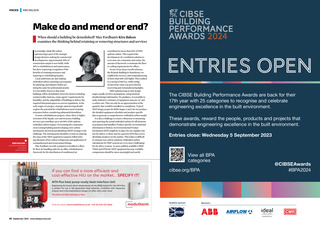




VOICES | KIRU BALSON Make do and mend or end? When should a building be demolished? Max Fordhams Kiru Balson examines the thinking behind retaining or removing structures and services I KIRU BALSON is principal sustainability consultant, Max Fordham ncreasingly, whole life carbon optioneering is part of the strategic design decision-making for commercial developments. Approximately 60% of construction output is new-build, while 40% is refurbishment and maintenance, but there is growing recognition of the benefits of retaining structures and repairing or refurbishing faades. Local authorities are also making embodied carbon reporting a prerequisite for planning, and industry bodies are doing the same for professional awards. It is inevitable, however, that some buildings will be demolished, driven by factors including commerciality, land use, estate agents requirements for lettability, and the adaptability of buildings to deliver the required functional spaces to current regulations. At the early stages of a project, strategic optioneering should explore the potential for refurbishment aned retaining structures before considering substantial demolition. In some refurbishment projects, where there is higher retention of the faade, core and structure, building services can contribute up to 40-50% of the upfront embodied carbon impact. Overcoming the constraints of an existing building and developing a low carbon mechanical, electrical and plumbing (MEP) strategy is the challenge. The starting point should be to look at reducing the mass of the MEP equipment required, followed by specification of low carbon refrigerants and application of remanufactured and rewarrantied fittings. Max Fordham recently compared centralised vs floorby-floor air handling units for an office refurbishment. Ductwork for the distribution of conditioned air contributed to more than 65% of MEP upfront carbon. This required the development of a ventilation solution to overcome site constraints and reduce the amount of ductwork, to maintain the floorto-ceiling requirements for offices. In one of our deep-retrofit schemes, the Rylands Building in Manchester, we enabled the recovery and remanufacturing of more than 600 LED lights. This resulted in a saving of 14tCO2e, while 644kg of electronic waste was prevented by recovering and remanufacturing lights. MEP optioneering at early design stages usually involves assumptions, using minimal detailed design information. For guidance, it is possible to make indicative estimates of equipment mass per m2 and a carbon rate. This can only be an approximation of the quantity that would be installed on completion. Typical MEP design scopes for RIBA Stages 2 and 3 do not produce the detailed equipment schedules and product-specific data to generate a comprehensive embodied carbon model. It is also a challenge to ensure robustness in measuring and reporting the actual embodied carbon for all elements as proposed and installed. Product-specific environmental information is limited. An Environmental Product Declaration (EPD) might be in place for one supplier, but not for others, or there may be a generic EPD that covers all similar products on the market. This makes it difficult to compare low carbon solutions. Embodied carbon calculations for MEP systems are even more challenging for the above reasons. As more publicly available CIBSE TM65 and EPDs for MEP equipment become available, comparisons should be more meaningful and useful. If you can find a more efficient and cost-effective HIU on the market... SPECIFY IT! MTA Plus heat pump-ready Heat Interface Unit Registering the lowest return temperatures of any BESA tested HIU, the MTA Plus is perfect for use in 4th generation heat networks. Combined with impressive outputs and a low maintenance design, no other units come close! The future of heat networks is here. Find out more: www.modutherm.co.uk +44 (0) 345 521 5666 46 September 2023 www.cibsejournal.com